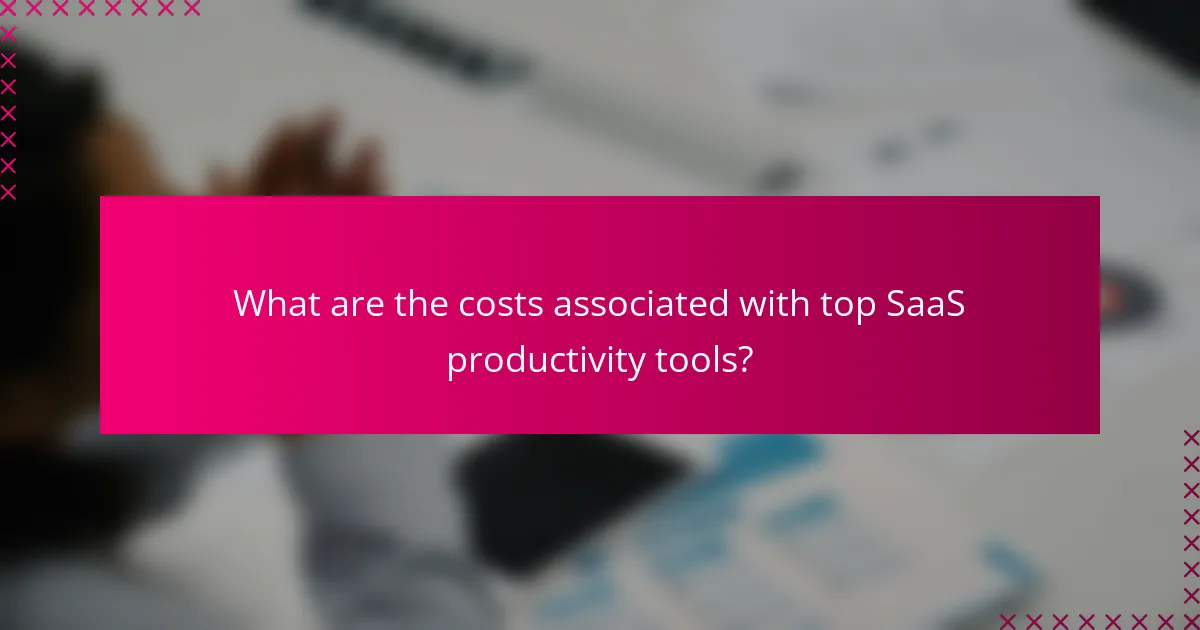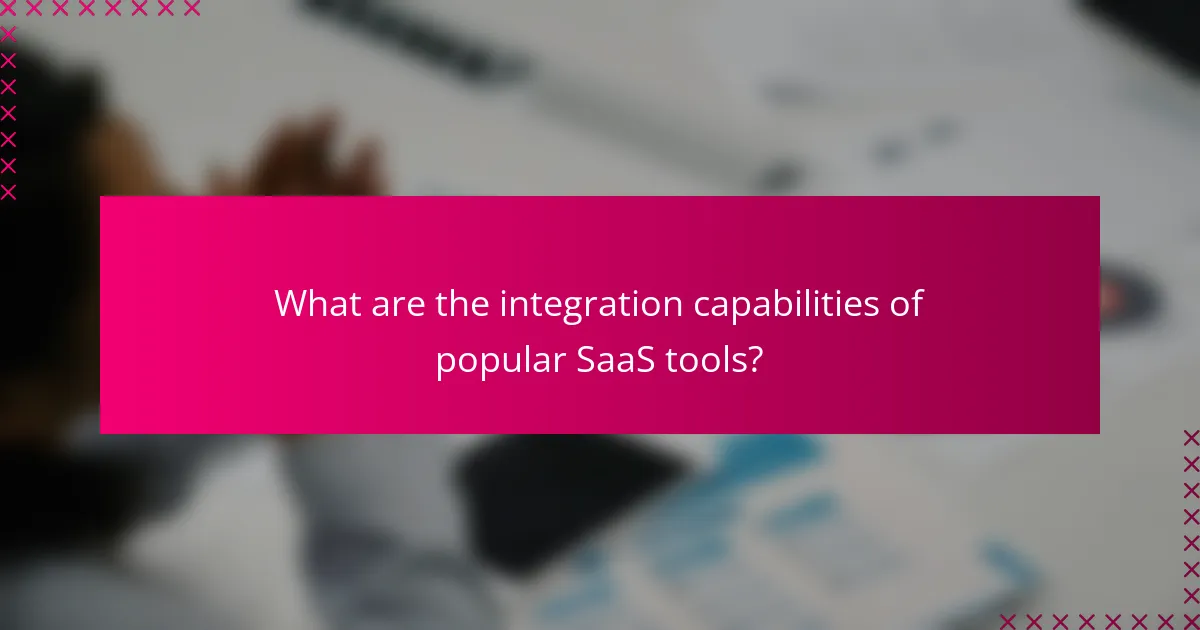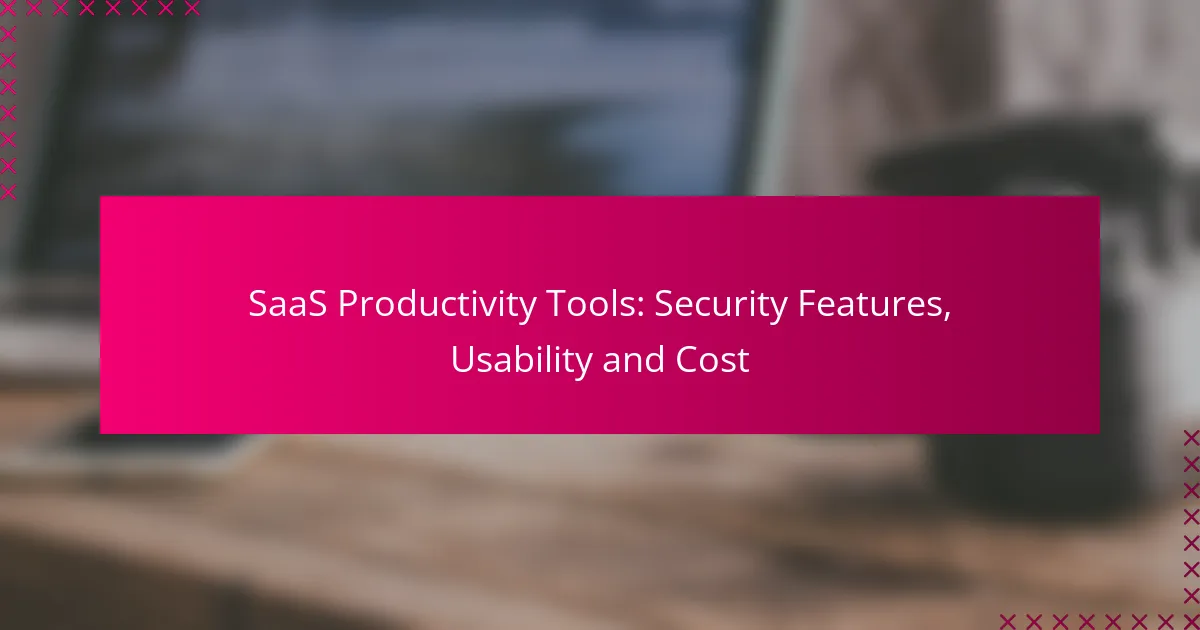SaaS productivity tools are essential for modern businesses, offering a blend of security features, usability, and cost-effectiveness. Platforms like Microsoft 365, Slack, and Asana not only prioritize data protection but also provide user-friendly interfaces that enhance workflow and efficiency. However, the pricing for these tools can vary widely, making it crucial for organizations to assess their specific needs and budget when selecting the right solution.

What are the best SaaS productivity tools for security features in the UK?
In the UK, top SaaS productivity tools with robust security features include Microsoft 365, Slack, and Asana. These platforms prioritize data protection and compliance with regulations, making them suitable for businesses looking to enhance their security posture.
Microsoft 365 Security Features
Microsoft 365 offers a comprehensive suite of security features designed to protect user data and maintain compliance. Key elements include advanced threat protection, data loss prevention, and encryption for emails and files. These features help safeguard sensitive information from unauthorized access.
Additionally, Microsoft 365 complies with UK data protection regulations, such as the GDPR, ensuring that businesses can trust their data is handled securely. Regular updates and security patches further enhance the platform’s resilience against emerging threats.
Slack Security Features
Slack provides a range of security features that focus on protecting team communications and data. These include enterprise-grade encryption, two-factor authentication, and customizable access controls to manage user permissions effectively. Such measures help mitigate risks associated with data breaches.
For UK businesses, Slack’s compliance with GDPR and other relevant regulations is crucial. The platform also allows for integration with third-party security tools, enabling organizations to tailor their security approach according to specific needs.
Asana Security Features
Asana emphasizes security through features like data encryption, secure user authentication, and regular security audits. These elements work together to protect project data and ensure that only authorized users can access sensitive information. Asana also offers customizable permissions to control access at the project level.
Moreover, Asana adheres to GDPR requirements, making it a reliable choice for UK companies. Users can benefit from detailed audit logs that track changes and access, providing transparency and accountability in project management.

How do usability and user experience impact SaaS productivity tools?
Usability and user experience are critical in SaaS productivity tools as they directly affect user adoption and efficiency. A well-designed interface can enhance workflow, reduce training time, and increase overall satisfaction, while poor usability can lead to frustration and decreased productivity.
Intuitive Interfaces in Trello
Trello’s intuitive interface allows users to easily create boards, lists, and cards, facilitating straightforward project management. The drag-and-drop functionality enables quick adjustments, making it simple for teams to organize tasks visually.
To maximize usability, Trello offers customizable templates that cater to various workflows, from simple task lists to complex project tracking. Users should explore these templates to find the best fit for their needs, which can significantly streamline their processes.
User Feedback in Monday.com
Monday.com prioritizes user feedback by incorporating it into their design updates and feature enhancements. This responsiveness ensures that the platform evolves based on real user experiences, making it more aligned with the needs of its audience.
To leverage this feedback-driven approach, users can participate in community forums and surveys, sharing their insights and suggestions. Engaging with these platforms not only helps improve the tool but also fosters a sense of community among users, enhancing the overall experience.

What are the costs associated with top SaaS productivity tools?
The costs of top SaaS productivity tools can vary significantly based on features, user count, and subscription models. Generally, businesses should expect to pay anywhere from a few dollars to several hundred dollars per user per month, depending on the tool’s capabilities and the level of service required.
Pricing Models of Notion
Notion offers a tiered pricing model that includes a free version, a Personal plan, a Team plan, and an Enterprise plan. The Personal plan typically costs around $5 per month, while the Team plan is approximately $10 per user per month, providing additional collaboration features.
For larger organizations, the Enterprise plan offers custom pricing based on specific needs, which may include advanced security features and dedicated support. Businesses should evaluate their requirements to choose the most cost-effective option.
Cost Comparison of ClickUp
ClickUp features several pricing tiers, starting with a free version that includes basic functionalities. Paid plans range from about $5 to $19 per user per month, depending on the features included, such as time tracking and integrations.
When comparing costs, consider the number of users and the specific features your team needs. The higher-tier plans offer more advanced tools that can enhance productivity, but it’s essential to assess whether these features justify the additional expense for your organization.

What security certifications should SaaS tools have?
SaaS tools should ideally have certifications like ISO 27001 and GDPR compliance to ensure robust security practices and data protection. These certifications demonstrate a commitment to safeguarding user data and adhering to industry standards.
ISO 27001 Compliance
ISO 27001 is an international standard that outlines best practices for an information security management system (ISMS). Compliance indicates that a SaaS provider has implemented a systematic approach to managing sensitive company information, ensuring its confidentiality, integrity, and availability.
When evaluating ISO 27001 compliance, consider whether the provider undergoes regular audits and updates their security measures. Look for certifications from accredited bodies, which can provide assurance of adherence to the standard.
GDPR Compliance
GDPR, or the General Data Protection Regulation, is a regulation in the European Union that governs data protection and privacy. SaaS tools that are GDPR compliant must ensure that personal data is processed lawfully, transparently, and securely.
To verify GDPR compliance, check if the SaaS provider has clear data processing agreements and privacy policies. They should also offer features like data encryption and the ability to delete user data upon request, which are essential for meeting GDPR requirements.

How to evaluate SaaS productivity tools for your business?
To evaluate SaaS productivity tools, focus on their security features, usability, and cost. Assess how well these tools align with your business needs and compliance requirements, ensuring they provide value without compromising on safety or user experience.
Feature Comparison Matrix
A feature comparison matrix helps you visualize the strengths and weaknesses of different SaaS productivity tools. List key features such as collaboration capabilities, integration options, security measures, and customer support to make informed decisions.
For example, you might compare tools based on their file sharing options, real-time editing capabilities, and data encryption standards. This matrix can highlight which tools best meet your specific operational needs and budget constraints.
User Reviews and Ratings
User reviews and ratings provide insight into the real-world performance of SaaS productivity tools. Look for platforms that aggregate user feedback, allowing you to gauge satisfaction levels and identify common issues.
Pay attention to reviews that mention usability and customer support, as these factors can significantly impact your experience. Aim for tools with high ratings and positive feedback, ideally from users in similar industries or business sizes to yours.

What are the integration capabilities of popular SaaS tools?
Popular SaaS tools often feature robust integration capabilities that allow them to connect with various applications and services. These integrations enhance functionality, streamline workflows, and improve data exchange across platforms.
Zapier Integrations with Various Tools
Zapier is a widely used automation tool that connects over 3,000 apps, enabling users to create workflows known as “Zaps.” These Zaps automate tasks between applications, such as transferring data from a form submission in Google Forms to a spreadsheet in Google Sheets.
When using Zapier, consider the pricing tiers, as the number of Zaps and tasks per month varies. The free plan allows for basic automation, while paid plans offer advanced features like multi-step Zaps and premium app integrations.
API Access in Salesforce
Salesforce provides extensive API access, allowing developers to integrate its CRM functionalities with other applications. This access enables custom solutions, such as syncing customer data between Salesforce and marketing platforms like Mailchimp.
When leveraging Salesforce APIs, be aware of the limits on API calls, which can vary based on your subscription level. Properly managing these limits is crucial to ensure uninterrupted service and data flow.

What emerging trends are shaping SaaS productivity tools?
Emerging trends in SaaS productivity tools focus on enhancing user experience, security, and adaptability to modern work environments. Key developments include AI-driven features and adaptations for remote work, which are transforming how teams collaborate and manage tasks.
AI-Driven Features
AI-driven features are increasingly integrated into SaaS productivity tools to automate routine tasks and enhance decision-making. These features can include intelligent scheduling, predictive analytics, and natural language processing, which help users streamline workflows and improve efficiency.
For instance, tools that utilize AI can analyze user behavior to suggest optimal times for meetings or prioritize tasks based on deadlines and importance. This not only saves time but also reduces the cognitive load on users, allowing them to focus on more strategic activities.
When selecting a tool with AI capabilities, consider the learning curve and how well the AI adapts to your specific needs. Look for platforms that offer customizable settings to ensure the AI aligns with your workflow preferences.
Remote Work Adaptations
Remote work adaptations in SaaS productivity tools are essential for supporting distributed teams. Features such as real-time collaboration, cloud storage, and mobile access are designed to facilitate seamless communication and project management, regardless of location.
Tools that offer integrated video conferencing, task tracking, and document sharing can significantly enhance team collaboration. For example, platforms like Slack or Microsoft Teams allow users to communicate instantly while managing projects in one place, which is crucial for remote work success.
When choosing a SaaS tool for remote work, prioritize those that provide robust security features to protect sensitive information. Ensure the tool complies with relevant regulations, such as GDPR, to safeguard your data and maintain trust within your team.
